Optimizing Treatment of Pediatric Atopic Dermatitis - Episode 8
Monoclonal Antibody Therapy for Pediatrics With AD
Transcript:
Lawrence Eichenfield, MD: Let’s move over specifically to look at dupilumab in pediatrics. Let’s start with the basics. This was a designed biologic agent that tried to hit a specific target of cytokines that were considered to be important in atopic dermatitis, it’s an alpha receptor, and it blocks IL-4 and IL-13. The proof of the pudding is in the eating, they say. How do I know the IL-4 and the IL-13 are important in atopic dermatitis? If you block them, a lot of patients get remarkably better. Again, they get better essentially in terms of all the parameters of atopic dermatitis. Their objective measures of eczema get better. Their body surface area goes down. They get clearness in a percentage of patients. Their itch can decrease. Their secondary infections have been shown to decrease. The quality-of-life scores improve, and even anxiety and depression scores improve. It shows the power of that cytokine pathway.
Specifically looking at pediatrics, where are we in the process of utilizing them? When it was approved in adults, we would struggle to get off-label utilization in some patients. Actually, Elaine Siegfried was 1 of the leaders collecting communal experience with that. But now we’ve had more significant experience in terms of clinical studies for the approval of 12- to 18-year-olds, recently extended down to age 6, with some interesting dosing regimens.
The adolescent study studied very severe patients. It showed a lower rate of clear or almost clear that we had seen with adults, but also a lower rate of clear or almost clear compared with the placebo group. The placebo group in the adolescent trial didn’t include topical corticosteroids. It was what I called a tough-love study. It was really trying to show efficacy in that age group. And the delta, the difference between the placebo and those who received the dupilumab, was about the same as the adults but the absolute level was lower. Although in other studies with longer-term use it improves in terms of the clear or almost clear, like in my clinical practice. When you have very severe adolescents, it takes longer to get through the lichenification aspects of the disease and get them more into either 75% improvement, which we call the EASI 75 eczema area and severity index, or they’re clear or almost clear.
Then what came along were the earlier studies of younger kids, and they had incredibly good results. They had results that were actually a little better than the adults. These studies were designed with topical corticosteroids, so patients got topical corticosteroids plus their dupilumab. It was predominantly a safety study, and it showed that 75% of the patients got 75% improvement in 16 weeks. An easy number to remember and discuss: 75% EASI 75 in 4 months of treatment. It probably continues to get better over time as well.
Regarding the safety profile, in the pediatric analysis, studies were essentially the same as adults. You get probably a 10% rate of conjunctivitis in the shorter-term use. Other than that, nothing really has popped up that’s more significantly of concern in kids as compared with the adult trials. There’s no need for blood monitoring in the kid data, and adolescent data came in similar to the adults in that particular regard. There were no laboratory abnormalities that require either baseline abnormalities or monitoring over time. Any comments on the dupilumab data?
Fred Ghali, MD: I thought what was interesting, Larry, is the onset of action. To Peter’s point, the systemic immunosuppressants are slowpokes with the exception of cyclosporine. It’s really interesting to see how both the EASI scores in some of the patient-reported outcomes occurred early in the course of treatment, sometimes within a few weeks or a few months. That’s important for our patients because it answers the big burden for our patients. Seeing the decrease in pruritus, it was a big factor in those studies.
Transcript Edited for Clarity



